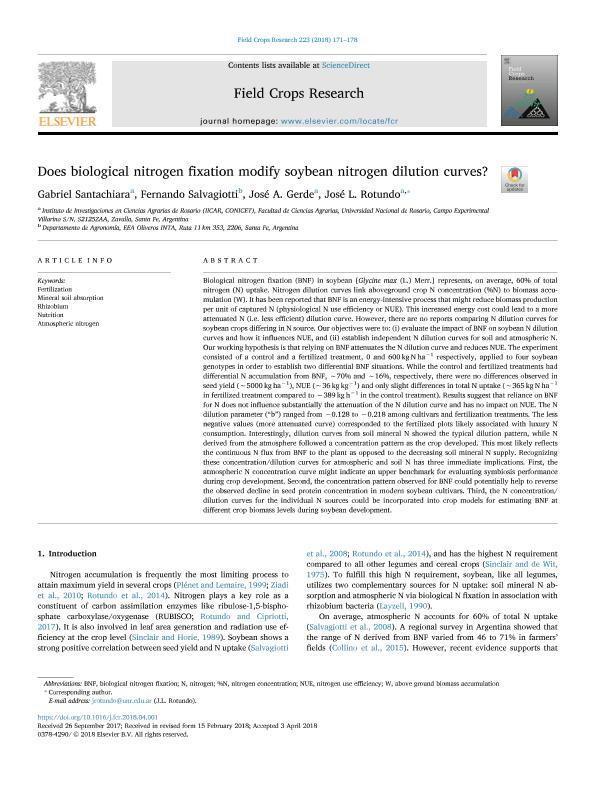Mostrar el registro sencillo del ítem
dc.contributor.author
Santachiara, Gabriel

dc.contributor.author
Salvagiotti, Fernando

dc.contributor.author
Gerde, Jose Arnaldo

dc.contributor.author
Rotundo, José Luis

dc.date.available
2019-11-25T21:35:28Z
dc.date.issued
2018-06
dc.identifier.citation
Santachiara, Gabriel; Salvagiotti, Fernando; Gerde, Jose Arnaldo; Rotundo, José Luis; Does biological nitrogen fixation modify soybean nitrogen dilution curves?; Elsevier Science; Field Crops Research; 223; 6-2018; 171-178
dc.identifier.issn
0378-4290
dc.identifier.uri
http://hdl.handle.net/11336/90378
dc.description.abstract
Biological nitrogen fixation (BNF) in soybean [Glycine max (L.) Merr.] represents, on average, 60% of total nitrogen (N) uptake. Nitrogen dilution curves link aboveground crop N concentration (%N) to biomass accumulation (W). It has been reported that BNF is an energy-intensive process that might reduce biomass production per unit of captured N (physiological N use efficiency or NUE). This increased energy cost could lead to a more attenuated N (i.e. less efficient) dilution curve. However, there are no reports comparing N dilution curves for soybean crops differing in N source. Our objectives were to: (i) evaluate the impact of BNF on soybean N dilution curves and how it influences NUE, and (ii) establish independent N dilution curves for soil and atmospheric N. Our working hypothesis is that relying on BNF attenuates the N dilution curve and reduces NUE. The experiment consisted of a control and a fertilized treatment, 0 and 600 kg N ha−1 respectively, applied to four soybean genotypes in order to establish two differential BNF situations. While the control and fertilized treatments had differential N accumulation from BNF, ∼70% and ∼16%, respectively, there were no differences observed in seed yield (∼5000 kg ha−1), NUE (∼36 kg kg−1) and only slight differences in total N uptake (∼365 kg N ha−1 in fertilized treatment compared to ∼389 kg h−1 in the control treatment). Results suggest that reliance on BNF for N does not influence substantially the attenuation of the N dilution curve and has no impact on NUE. The N dilution parameter (“b”) ranged from −0.128 to −0.218 among cultivars and fertilization treatments. The less negative values (more attenuated curve) corresponded to the fertilized plots likely associated with luxury N consumption. Interestingly, dilution curves from soil mineral N showed the typical dilution pattern, while N derived from the atmosphere followed a concentration pattern as the crop developed. This most likely reflects the continuous N flux from BNF to the plant as opposed to the decreasing soil mineral N supply. Recognizing these concentration/dilution curves for atmospheric and soil N has three immediate implications. First, the atmospheric N concentration curve might indicate an upper benchmark for evaluating symbiosis performance during crop development. Second, the concentration pattern observed for BNF could potentially help to reverse the observed decline in seed protein concentration in modern soybean cultivars. Third, the N concentration/dilution curves for the individual N sources could be incorporated into crop models for estimating BNF at different crop biomass levels during soybean development.
dc.format
application/pdf
dc.language.iso
eng
dc.publisher
Elsevier Science

dc.rights
info:eu-repo/semantics/openAccess
dc.rights.uri
https://creativecommons.org/licenses/by-nc-nd/2.5/ar/
dc.subject
ATMOSPHERIC NITROGEN
dc.subject
FERTILIZATION
dc.subject
MINERAL SOIL ABSORPTION
dc.subject
NUTRITION
dc.subject
RHIZOBIUM
dc.subject.classification
Agricultura

dc.subject.classification
Agricultura, Silvicultura y Pesca

dc.subject.classification
CIENCIAS AGRÍCOLAS

dc.title
Does biological nitrogen fixation modify soybean nitrogen dilution curves?
dc.type
info:eu-repo/semantics/article
dc.type
info:ar-repo/semantics/artículo
dc.type
info:eu-repo/semantics/publishedVersion
dc.date.updated
2019-10-23T20:51:16Z
dc.journal.volume
223
dc.journal.pagination
171-178
dc.journal.pais
Países Bajos

dc.journal.ciudad
Amsterdam
dc.description.fil
Fil: Santachiara, Gabriel. Consejo Nacional de Investigaciones Científicas y Técnicas. Centro Científico Tecnológico Conicet - Rosario. Instituto de Investigaciones en Ciencias Agrarias de Rosario. Universidad Nacional de Rosario. Facultad de Ciencias Agrarias. Instituto de Investigaciones en Ciencias Agrarias de Rosario; Argentina. Universidad Nacional de Rosario. Facultad de Ciencias Agrarias; Argentina
dc.description.fil
Fil: Salvagiotti, Fernando. Instituto Nacional de Tecnología Agropecuaria. Centro Regional Santa Fe. Estación Experimental Agropecuaria Oliveros; Argentina. Consejo Nacional de Investigaciones Científicas y Técnicas; Argentina
dc.description.fil
Fil: Gerde, Jose Arnaldo. Consejo Nacional de Investigaciones Científicas y Técnicas. Centro Científico Tecnológico Conicet - Rosario. Instituto de Investigaciones en Ciencias Agrarias de Rosario. Universidad Nacional de Rosario. Facultad de Ciencias Agrarias. Instituto de Investigaciones en Ciencias Agrarias de Rosario; Argentina
dc.description.fil
Fil: Rotundo, José Luis. Consejo Nacional de Investigaciones Científicas y Técnicas. Centro Científico Tecnológico Conicet - Rosario. Instituto de Investigaciones en Ciencias Agrarias de Rosario. Universidad Nacional de Rosario. Facultad de Ciencias Agrarias. Instituto de Investigaciones en Ciencias Agrarias de Rosario; Argentina
dc.journal.title
Field Crops Research

dc.relation.alternativeid
info:eu-repo/semantics/altIdentifier/url/https://www.sciencedirect.com/science/article/pii/S0378429017316143
dc.relation.alternativeid
info:eu-repo/semantics/altIdentifier/doi/http://dx.doi.org/10.1016/j.fcr.2018.04.001
Archivos asociados
